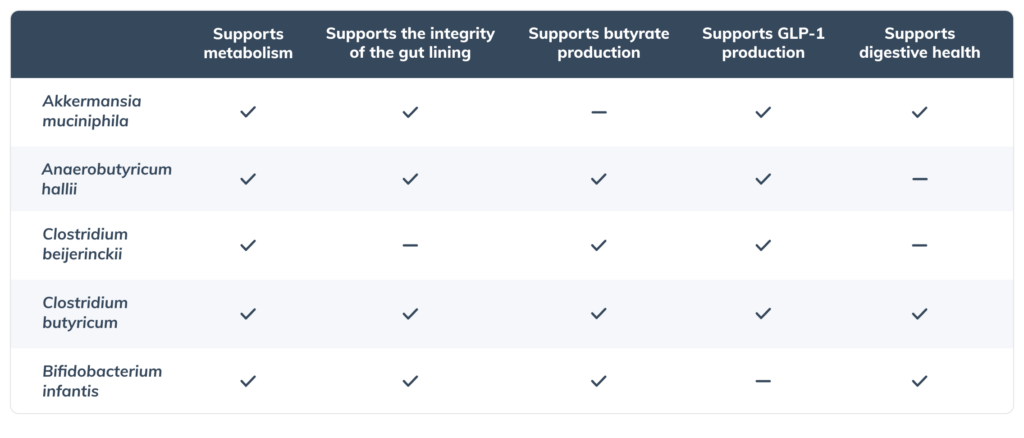In 2021, it was estimated that 38% of the U.S. adult population had pre-diabetes. Thankfully, research has identified strategies for supporting individuals with diabetes and other metabolic disorders, such as a nutrient-rich diet, regular physical activity, weight management, quality sleep, smoking cessation, and routine health monitoring. (4)
But where do dietary supplements come in? Supplements containing certain probiotics are being recognized for their potential to promote metabolic health by supporting the integrity of the gut lining, creating an optimal ecosystem of favorable bacteria, and producing beneficial metabolites such as short-chain fatty acids (SCFAs). (10)(13)
If you’re a practitioner looking to recommend probiotic supplements, create a free Fullscript account today.
Try Fullscript for free
Importance of metabolic health
Metabolic disease refers to various disorders affecting metabolism, the ongoing biochemical processes by which the body produces and consumes energy to maintain life. (14) A metabolic disorder may occur when metabolism is disrupted by abnormal chemical reactions in the body, affecting its ability to efficiently break down food to use as fuel or store as energy. (14) Lastly, metabolic disorders may be inherited (genetic) or acquired and influenced by different factors, such as diet, environment, and physical activity levels. (9)
Some examples of acquired metabolic disorders include:
- Metabolic syndrome: a cluster of conditions that increase the risk of heart disease, stroke, and type 2 diabetes (9)
- Non-alcoholic fatty liver disease (NAFLD): a condition characterized by the accumulation of fat in the liver and associated with obesity and insulin resistance (17)
- Osteoporosis: a condition characterized by low bone mass and the deterioration of bone tissue (9)(20)
- Obesity: a condition characterized by an abnormal accumulation of adipose tissue or fat in the body that may have negative health implications. (9)
- Type 2 diabetes: a condition associated with insulin resistance and elevated blood sugar levels (9)
Benefits of probiotics for metabolic health
Researchers continue to study the relationship between the health of an individual’s microbiota and their metabolic health. In fact, recent studies have begun evaluating the efficacy of certain probiotics and their potential benefits to both digestive and metabolic health. Some of these benefits include:
1. Balancing gut microbiota: Probiotics may help support a diverse and balanced gut microbiota. An imbalance in gut bacteria (dysbiosis) has been associated with obesity and insulin resistance. (5)(13)
2. Regulating inflammation: Chronic inflammation is associated with metabolic disorders like insulin resistance. Probiotics may be anti-inflammatory, help reduce systemic inflammation, and support metabolic health. (5)(13)
3. Producing SCFAs: Certain probiotics support the fermentation of dietary fibers, producing SCFAs like butyrate, which has been shown to benefit metabolism and promote insulin sensitivity. (10)(13)
4. Affecting appetite and weight: Certain probiotics may influence appetite-regulating hormones, such as glucagon-like peptide-1 (GLP-1), potentially supporting weight management. (13)(16)(24)
5. Metabolizing lipids: Probiotics may help regulate lipid metabolism and positively affect cholesterol levels. (13)

Supporting metabolic health with probiotics
The following probiotic strains have been researched for their potential role in supporting both digestive and metabolic health:
- Akkermansia muciniphila
- Anaerobutyricum hallii
- Bifidobacterium infantis
- Bifidobacterium longum
- Clostridium beijerinckii
- Clostridium butyricum
1. Akkermansia muciniphila
Akkermansia muciniphila (A. muciniphila) is an anaerobic bacteria that resides in the human colon and accounts for 1 to 4% of adult intestinal bacteria. (Naito et al. 2018) A. muciniphila helps regulate the mucosal lining of the gut, minimize gut permeability, and maintain an optimal ecosystem of beneficial bacteria. Additionally, studies have demonstrated that A. muciniphila is directly or indirectly involved in human metabolic responses, including affecting glucose and lipid metabolism. (13)
One proposed mechanism for A. muciniphila affecting glucose and lipid metabolism is its potential to increase GLP-1 levels, a hormone important for stimulating the release of insulin in the body and influencing satiety and appetite. (3)(24)
A. muciniphila may produce acetic acid and SCFAs from mucin (a glycoprotein that supports the mucous layer of the gut), helping to regulate and potentiate the integrity of the gut lining. Additionally, studies suggest that A. muciniphila levels may be lower in individuals with high body weights, body mass indexes (BMIs), blood cholesterol levels, and fasting blood glucose levels when compared to healthy individuals. (13)(21)
In one animal study, diabetic mice that were fed a high-fat diet were shown to have high blood lipopolysaccharide (LPS) concentrations, an indicator of increased intestinal permeability. After being administered A. muciniphila, their LPS levels decreased. Although additional studies are required, these results suggest that A. muciniphila may help address certain human metabolic disorders. (7)
Did you know? Polyphenols (phytonutrients that provide color to fruits and vegetables) act as prebiotics in the body and may increase the population of beneficial bacteria in the gut, such as A. muciniphila. (13)
2. Anaerobutyricum hallii
Anaerobutyricum hallii (A. hallii) is an anaerobic bacteria found in the human colon that utilizes glucose to produce beneficial metabolites such as butyrate—a SCFA that provides energy to cells lining the colon, helps maintain the integrity of the gut mucosa, and has anti-inflammatory properties. A. hallii may also increase GLP-1 levels. (2)(19)
Although healthy people generally have an abundance of A. hallii in their gut, studies suggest that individuals with type 2 diabetes and insulin resistance may have far less. (22)
3. Bifidobacterium longum and Bifidobacterium infantis
Bifodobacterium longum (B. longum) is an anaerobic species of bacteria passed down from the birthing person to their infant that colonizes the newborn’s gut in the first several days after birth. It’s the most abundant microbe in the infant’s gut at this stage (40 to 80%), and it persists as an important microbe for immune and metabolic health into adulthood. (5)
Babies born vaginally and who are breastfed may receive higher amounts of B. longum from their birthing and breastfeeding parent compared to babies born via cesarean section or who aren’t breastfed. (5) Additionally, researchers continue to examine a possible correlation between lower Bifidobacterium spp. in infants and chronic conditions such as obesity and asthma. (11)
Bifidobacterium infantis (B. infantis), a subspecies of B. longum, is especially abundant in breastfed infants. The metabolism of human milk oligosaccharides (HMOs) from breast milk supports the maturation of the immune system, the suppression of inflammation, and improves intestinal barrier function and SCFA production, such as acetate, butyrate, and lactate. (1)(5) These SCFAs also circulate in the body and may affect adipose tissue, the liver, brain, and lungs, and satiety and appetite regulation by crossing the blood-brain barrier. (8)(10)
4. Clostridium beijerinckii and Clostridium butyricum
Clostridium beijerinckii (C. beijerinckii) and Clostridium butyricum (C. butyricum) are anaerobic species of bacteria that belong to the Clostridium genus and are found in the intestines of humans and animals as well as in soil and water. C. beijerinckii is a spore-forming bacteria.
Both species support metabolic health by producing SCFAs such as butyrate through the fermentation of carbohydrates providing energy to gut-lining cells supporting immune health. They may also increase GLP-1 levels in the body. Additionally, C. butyricum supports the health of the intestinal mucosa. (16)
One multicenter, double-blind, randomized, placebo-controlled trial demonstrated that a multi-strain probiotic containing both C. beijerinckii and C. butyricum may support individuals with type 2 diabetes by regulating blood glucose levels. These results suggest that butyrate may positively affect the blood sugar response, however, further research is necessary. (16)
A summary of probiotic benefits
This table summarizes the different potential benefits of five probiotic bacteria species.

The bottom line
Certain probiotics are being recognized for their potential to support metabolic health. These probiotics support the integrity of the gut lining and influence appetite-regulating hormones such as glucagon-like peptide-1 (GLP-1). They also support an optimal ecosystem of beneficial bacteria for metabolizing sugars, converting food to energy, and producing metabolites such as butyrate and other SCFAs that benefit metabolism and promote insulin sensitivity.





